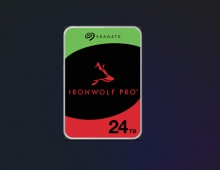
Seagate, AMCC and Marvell Preview First End-to-End 3-Gigabit-Per-Second SATA Technology
Seagate Technology, Marvell and AMCC, came together this week at the Intel Developer Forum to demonstrate, for the first time, End-to-End 3Gigabit per second (Gb/s) SATA technology.
Conforming to the newly released 3Gb/s speed specification, the demonstration features a Seagate Barracuda 7200.7 hard drive - employing the Marvell 88SA8050 3.0Gb/s SATA bridge chip - to a prototype AMCC 3Gb/s SATA host controller also incorporating the Marvell 88SA8050, demonstrating transfer rates from the host to the drive at up to 3Gb/s. Seagate, AMCC and Marvell are active leaders of the Serial ATA International Organization (SATA-IO) and helped define the 3Gb/s specification.
"Seagate was ahead of the industry in dedicating resources to SATA development, and today Seagate is reprising that leadership role by demonstrating that next-generation 3Gb/s technology will be on the way," said Marc Noblitt, SATA-IO Board Member and Seagate manager of I/O Planning. "Seagate's early delivery of SATA technology has helped component suppliers and system builders to quickly develop and adopt the technology for their products. This demonstration again shows technology leadership from three companies who have consistently driven the SATA standard from concept to reality to market."
"Marvell was the first to introduce 3Gb/s SATA silicon technology in April of 2003," commented Dr. Alan J. Armstrong, VP of Marketing for Marvell's Storage Division. "Since that time Marvell has developed System On Chip (SOC) products incorporating this technology for multiple hard disk drive OEMs and for the storage networking market as a whole. Marvell, AMCC and Seagate have worked together to demonstrate end-to-end 3Gb/s SATA technology, proving this new speed generation is ready for deployment."
"This technology demonstration presents a significant step forward towards realizing the full benefits of SATA technology into multiple tiers of storage solutions," said Barbara Murphy, vice president of Marketing at AMCC. "SATA 3Gb/s technology offers the required bandwidth to provide robust solutions that meet the increasing demand for capacity, performance and features at attractive price points."
As advancing applications demand increased speeds, and as hard drives' internal data transfer rates increase to meet those needs, engineers will need to ensure that external interface speeds always exceed the drive's internal data rates to avoid bottlenecks to performance. This will be especially important as customers start to integrate new SATA devices such as port multipliers, SATA RAID enclosures and backplanes where interface aggregation becomes more feasible. In such configurations, customers will ultimately see combined internal data transfer rates within a system that will require the external transfer rates that future 3Gb/s will enable.
When it becomes available in future products, the next-generation 3Gb/s interface speed will prove especially useful to applications like high-end game development, game playing and game loading; demanding film, photo and graphics editing and rendering; advanced AutoCAD work; intensive database use, and generally during application loading in any system.
The SATA 3Gb/s specification has now been ratified and publicly released by the SATA-IO. The industry expects to move SATA products to the higher speed within two years. Many component designers who have been members of the SATA organization have already been able to develop products due to their close involvement with the organization.
Hardware and software component designers may download the new specification today at www.serialata.org.
"Seagate was ahead of the industry in dedicating resources to SATA development, and today Seagate is reprising that leadership role by demonstrating that next-generation 3Gb/s technology will be on the way," said Marc Noblitt, SATA-IO Board Member and Seagate manager of I/O Planning. "Seagate's early delivery of SATA technology has helped component suppliers and system builders to quickly develop and adopt the technology for their products. This demonstration again shows technology leadership from three companies who have consistently driven the SATA standard from concept to reality to market."
"Marvell was the first to introduce 3Gb/s SATA silicon technology in April of 2003," commented Dr. Alan J. Armstrong, VP of Marketing for Marvell's Storage Division. "Since that time Marvell has developed System On Chip (SOC) products incorporating this technology for multiple hard disk drive OEMs and for the storage networking market as a whole. Marvell, AMCC and Seagate have worked together to demonstrate end-to-end 3Gb/s SATA technology, proving this new speed generation is ready for deployment."
"This technology demonstration presents a significant step forward towards realizing the full benefits of SATA technology into multiple tiers of storage solutions," said Barbara Murphy, vice president of Marketing at AMCC. "SATA 3Gb/s technology offers the required bandwidth to provide robust solutions that meet the increasing demand for capacity, performance and features at attractive price points."
As advancing applications demand increased speeds, and as hard drives' internal data transfer rates increase to meet those needs, engineers will need to ensure that external interface speeds always exceed the drive's internal data rates to avoid bottlenecks to performance. This will be especially important as customers start to integrate new SATA devices such as port multipliers, SATA RAID enclosures and backplanes where interface aggregation becomes more feasible. In such configurations, customers will ultimately see combined internal data transfer rates within a system that will require the external transfer rates that future 3Gb/s will enable.
When it becomes available in future products, the next-generation 3Gb/s interface speed will prove especially useful to applications like high-end game development, game playing and game loading; demanding film, photo and graphics editing and rendering; advanced AutoCAD work; intensive database use, and generally during application loading in any system.
The SATA 3Gb/s specification has now been ratified and publicly released by the SATA-IO. The industry expects to move SATA products to the higher speed within two years. Many component designers who have been members of the SATA organization have already been able to develop products due to their close involvement with the organization.
Hardware and software component designers may download the new specification today at www.serialata.org.





















